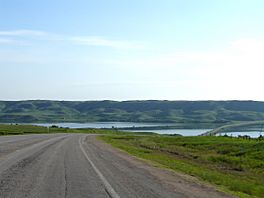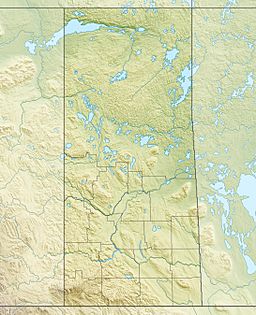Buffalo Pound Lake facts for kids
Quick facts for kids Buffalo Pound Lake |
|
|---|---|
 |
|
| Location | Saskatchewan |
| Coordinates | 50°39′00″N 105°30′50″W / 50.65000°N 105.51389°W |
| Lake type | Prairie lake |
| Primary inflows | Qu'Appelle River |
| Primary outflows | Qu'Appelle River |
| Catchment area | 3,310 km2 (1,280 sq mi) |
| Basin countries | Canada |
| First flooded | 1939 |
| Max. length | 35 km (22 mi) |
| Max. width | 2 km (1.2 mi) |
| Surface area | 29.5 km2 (11.4 sq mi) |
| Average depth | 3 m (9.8 ft) |
| Max. depth | 5.6 m (18 ft) |
| Water volume | 0.0898 km3 (0.0215 cu mi) |
| Residence time | 1.5 years |
| Shore length1 | 72.5 km (45.0 mi) |
| Surface elevation | 509.47 m (1,671.5 ft) above sea level |
| Islands | none |
| Settlements | none |
| 1 Shore length is not a well-defined measure. | |
Buffalo Pound Lake is a long, narrow lake in Saskatchewan, Canada. It's a "prairie lake," meaning it's found in flat, grassy areas. This lake was formed about 10,000 years ago by melting glaciers. It sits on the Qu'Appelle River, not far from the cities of Moose Jaw and Tuxford.
The lake's name comes from an old way First Nations people used to hunt bison. They would use the natural hills and valleys to create "buffalo pounds" or corrals to trap the animals. Bison were once very common, but by 1900, most were gone. Luckily, bison were brought back to this area in 1972.
Contents
Controlling Water Levels
The Buffalo Pound Dam was built on the Qu'Appelle River in 1939. This dam helps control how much water is in the lake. It's a long wall of earth, about 1400 meters (almost a mile) long.
Improvements to the Dam
In 1999 and 2000, some important changes were made to the dam. A special "fish ladder" was added. This ladder helps fish swim in and out of the lake easily. New gates were also put in to help control the water flow downstream. The dam was even made one meter taller!
Solving Water Flow Problems
Even with these changes, the lake's water levels still changed a lot. The big solution came in 1967 with the building of the Qu'Appelle River Dam and Gardiner Dam. These dams created Lake Diefenbaker, which is about 100 km upstream.
Now, the Qu'Appelle River's water flow stays pretty steady. This means the lake gets a constant supply of water. However, this cleaner water also led to more algae growing. This made swimming and boating less popular in summer. It also made water treatment more expensive. The lake still has lots of nutrients, which means it can have low oxygen levels.
A Source of Drinking Water
Buffalo Pound Lake is very important because it provides drinking water. It supplies water to the cities of Regina and Moose Jaw. It also provides water for The Mosaic Company potash mine near Belle Plaine. This means the lake provides water for about 25% of Saskatchewan's population!
Fun Activities at the Lake
People also use Buffalo Pound Lake for fun activities. You can go camping, boating, and fishing here. The lake is home to many different kinds of fish. Some of these include walleye, sauger, yellow perch, northern pike, and common carp.
Buffalo Pound Provincial Park is located on the southern side of the lake. You can get there by taking Highway 202 and Highway 301. If you want to stay longer, you can rent or buy cabins along the lake's shores.
Highway 2 crosses over the lake on a special road called a causeway. The Moose Jaw River also joins the Qu'Appelle River about 5 km east of the dam.
Images for kids



